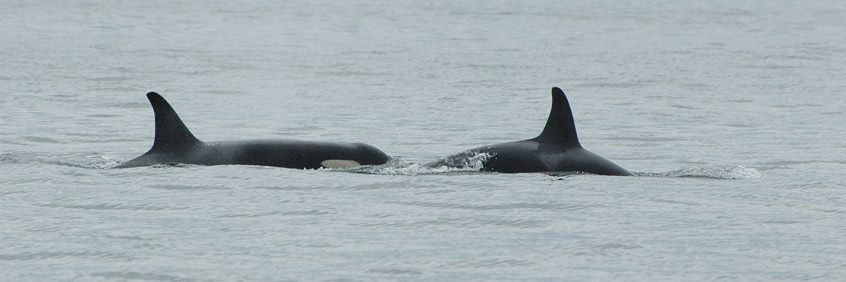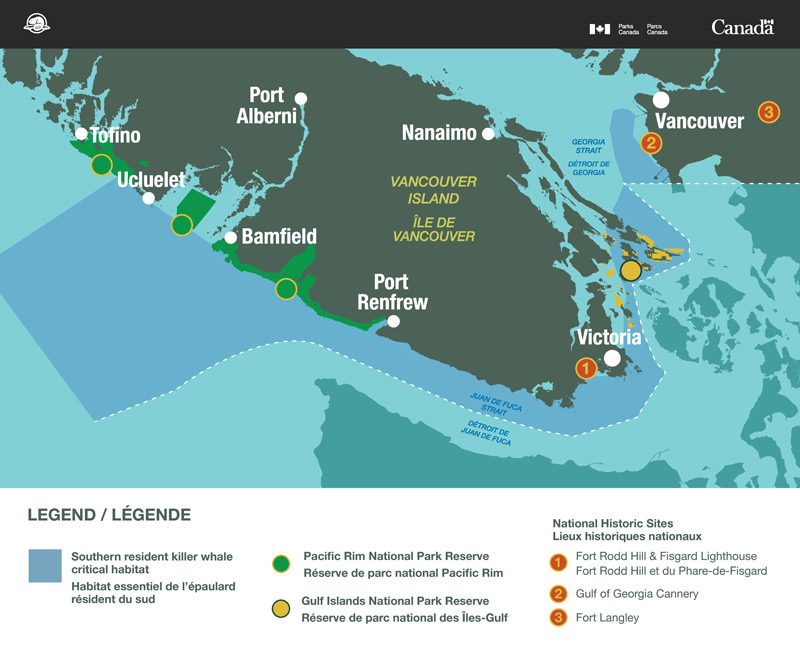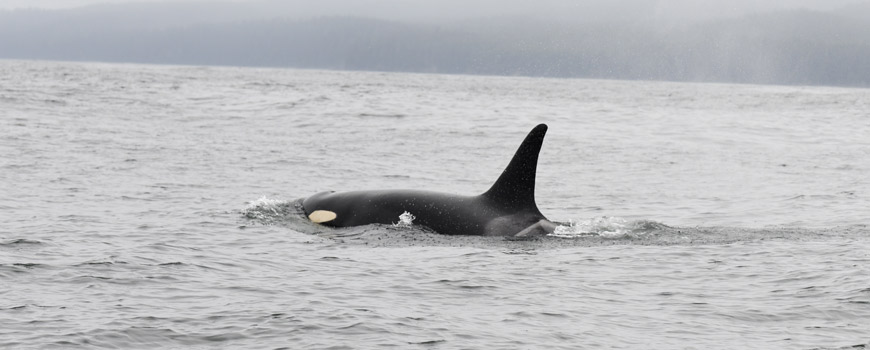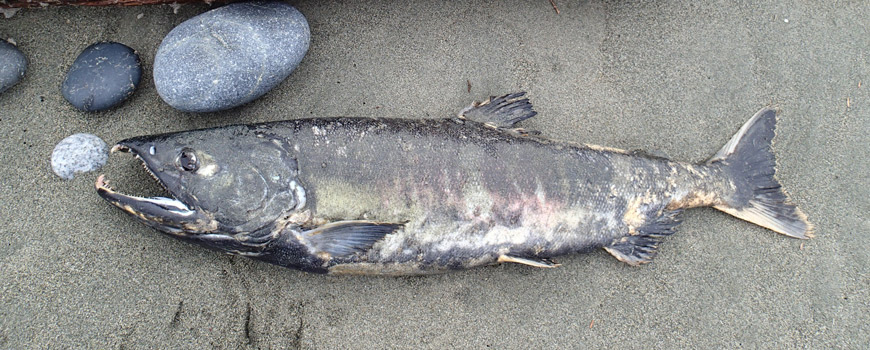
Southern Resident Killer Whale research project
Pacific Rim National Park Reserve
Overview
When you visit Pacific Rim National Park Reserve and look out at the Pacific Ocean, you are looking at Southern Resident Killer Whale habitat. Parks Canada, is working with Fisheries and Oceans Canada, Transport Canada, Indigenous partners, non-government organizations and academia to learn more about Southern Resident Killer Whales. Scientists are studying how the Southern Resident Killer Whales fit into the whole ecosystem, keeping with the Nuu-chah-nulth principle hišukiš t̓swak (everything is one).
Over the next five years, the Southern Resident Killer Whale science and monitoring program will address three key threats to Southern Resident Killer Whales: prey availability (food), physical and acoustic disturbance, and contaminants.
Hahuułi/Traditional territories
Killer Whales are an important part of the culture of the Nuu-chah-nulth people, as well as many other indigenous peoples. Amongst the Nuu-chah-nulth, there is great respect for killer whales, also known as kakaw̓in, or referred to as “relatives/family”. As a visitor to this place, you are in the hahuułi/traditional territories of nine Nuu-chah-nulth First Nations, including:
- Ditidaht First Nation
- Hupačasath First Nation
- Huu-ay-aht First Nations
- Pacheedaht First Nation
- Tseshaht First Nation
- Toquaht Nation
- Tla-o-qui-aht First Nations
- Uchucklesaht Tribe
- Yuułuʔiłʔatḥ Government
Southern Resident Killer Whales
There are three ecotypes of killer whale that can be found in British Columbia: Offshore, Transient (Bigg’s) and Residents. The Resident ecotype is divided into the Northern and Southern Resident populations. Although the two populations are sometimes found in the same areas, they do not interact or breed with each other. Both Northern and Southern Resident populations can be found in the waters off Pacific Rim National Park Reserve.
The Southern Resident Killer Whales are identified as endangered under the Species at Risk Act, with only 73 (as of September 2021) individuals remaining in the population. They typically spend the summer and fall months in the Salish Sea (Strait of Georgia, Haro Strait, Strait of Juan de Fuca, and Puget Sound), including areas around Pacific Rim National Park Reserve and Gulf Islands National Park Reserve.

Quick facts:
- They are a very social species that shares language and culture.
- Individuals spend their entire lives with their mothers.
- They are fish eaters. Chinook Salmon is an important prey for them year-round.
- Males can live 50-60 years and females for 90 years or more. The oldest Southern Resident Killer Whale, Granny (J-2), was estimated to be 105 years old when she died.
Scope of study
Parks Canada is contributing to the Government of Canada’s effort to support the recovery of Southern Resident Killer Whales in southern British Columbia. This research will help Parks Canada and local First Nations better understand how to support the recovery of Southern Resident Killer Whales and the entire food web.
There is also a research and monitoring effort in Gulf Islands National Park Reserve.Watch “Field Notes: Recovering Southern Resident Killer Whales” to go behind the scenes and learn more!
Contact us:
Media Requests
pc.medias-media.pc@canada.ca
1-819-420-9292
Research methods
Southern Resident Killer Whales – population demographics and habitat use

Parks Canada conducts visual surveys to learn where Southern Resident Killer Whales are in the marine waters of Pacific Rim National Park Reserve. Photo identification techniques are used to identify Southern Resident Killer Whale pods and individuals. Scientists also gather acoustic data from “listening stations” that use portable hydrophone systems (underwater microphones).
Report your sightings:
You can support this research by reporting your whale sightings to the BC Cetacean Sightings Network. Download the WhaleReport App or call 1-866-I-SAW-ONE. Your reports are used to obtain valuable information about distribution patterns and help in future recovery and management plans for species at risk like the Southern Resident Killer Whale.
Pinnipeds

Pinnipeds, such as Steller Sea Lions, share the marine waters with Southern Resident Killer Whales. Parks Canada is conducting research to assess the use of Sea Lion haul-outs in Pacific Rim National Park Reserve. Haul-outs are rocky outcrops near water, like in the photo above.
Parks Canada is also collaborating with Fisheries and Oceans Canada to collect Sea Lion scat (poo) samples in Pacific Rim National Park Reserve. The samples are analyzed to get more information about what Sea Lions eat.
Salmon

Southern Resident Killer Whales primarily eat Chinook Salmon.
Parks Canada is identifying stream systems that have previously supported Chinook Salmon and Chum Salmon populations in Pacific Rim National Park Reserve. This research helps Parks Canada monitor the health of salmon populations and support future stream restoration efforts. Stream restoration efforts provide habitat for spawning adults and safe nurseries for juveniles.
Eat sustainable seafood.
Many people like to eat fish. Choose the salmon you eat based on sustainable seafood guidelines such as Ocean Wise.
Forage Fish

Forage fish, like Pacific Sand Lance and Surf Smelt, are small fish that other larger fish and predators prey on for food. For example, Pacific Sand Lance are an important food source for Chinook Salmon.
Parks Canada is identifying important habitat for forage fish. These habitats include:
- Intertidal spawning habitat for Pacific Sand Lance and Surf Smelt
- Subtidal burying habitat for Pacific Sand Lance, and;
- Pelagic foraging habitats for Pacific Sand Lance, Surf Smelt, Pacific Herring and Shiner Perch.
Scientists will continue to monitor changes in forage fish populations over the next five years in Pacific Rim National Park Reserve.
Contaminants of concern
Parks Canada is working with Ocean Wise to expand Ocean Wise’s Pollution Tracker program through the addition of a sample location in Pacific Rim National Park Reserve.
You can support the recovery of Southern Resident Killer Whales
Follow all protection measures to protect Southern Resident Killer Whales. By adopting good practices in our daily lives, we contribute to protection efforts. Your participation is essential.
- Stay 400m away from Killer Whales in all southern BC coastal waters between Campbell River and just north of Ucluelet (including Barkley Sound). It's the law.
- Slow down to no more than 10 knots in Speed Restricted Areas in portions of Swifsure Bank.
- In effect June 1 to November 30
- No recreational or commercial salmon fishing in portions of Southern Resident Killer Whale key foraging areas. Closures will be in place in the following locations:
- In a portion of Swiftsure Bank following Chinook non-retention measures to October 31, 2023, and;
- In portions of the Strait of Juan de Fuca following Chinook non-retention measures to October 31, 2023.
Additional ways you can help:
- If a killer whale appears near you, turn your engine to neutral and let the whale pass.
- Stop fishing (do not haul gear) when within 1000 metres of killer whales
- Go Slow! Reduce your speed to less than 7 knots when you’re within 1000 metres of the nearest marine mammal
- Turn off echo sounders and fish finders when safe to do so
- Be Whale Wise. For more information on the best ways to help whales while on the water, please visit bewhalewise.org and seeablowgoslow.org.
Reporting violations and incidents involving marine mammals
When you are in Pacific Rim National Park Reserve, please call Parks Canada Emergency Dispatch to report any violations or incidents involving marine mammals to Park Wardens or the appropriate Parks Canada team member.
If you are outside of the Pacific Rim National Park Reserve, please report any violations or incidents involving marine mammals (that you overserved or were involved in) to Fisheries and Oceans Canada’s 24/7 Observe, Record, Report Line:
Related links
- Date modified :